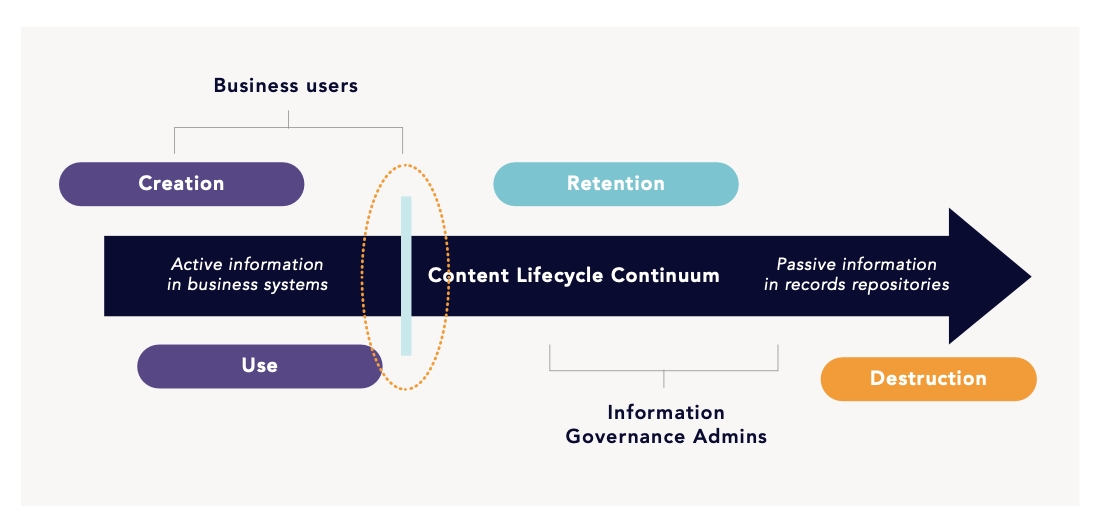How content intelligence is changing the use and management of information
The content lifecycle times, they are a-changin'! In the good old days of information governance, the management lines between active content for use and passive content for retention were clear.
I remember the first time I was introduced to this concept by my colleague and now EncompaaS Chief Product Officer, Jaimie Tilbrook. He explained it to me 13 years ago, on a whiteboard in his Adelaide, Australia office. Below is a replica of his drawing:
Users created and consumed content during the active phase, and information governance and records managers became the custodian of passive content to ensure proper management until the end of lifecycle.
The main takeaway was that a solid, defined vertical border existed on a continuum (see orange circle) between active content, such as a Standard Operating Procedure or business plan (in use by the creator and anyone working on a similar project), and passive content, such as meeting minutes, or prior versions of travel policies that needed to be retained (because they were considered a record).
For many years, this time-based continuum featured a hard line between what was considered active and what was considered passive. It was the methodology norm for content use and lifecycle management of information. Once in a passive stage, the content usually never saw the light of day again, except for legally bound search. However, as noted lyricist Bob Dylan wrote early in his career: “The times, they are a-changin'”.
Today, we are seeing not just a blurring of the distinction between active and passive management of content; we are seeing an obliteration of the entire concept. The data lake, once the exclusive milieu for the rows-and columns-based data, is extending to the petabytes of unstructured and semi-structured content found in Microsoft 365, OneDrive, file shares, and hundreds of information repositories strewn across the enterprise.
The methodology transformation is enabled by new advances in machine learning and artificial intelligence, making it possible not only to classify information with great accuracy but also to find concepts and passages that are useful and required to support better business decision-making. It is what we at EncompaaS call content intelligence.
Content intelligence is the next generation of content management, where AI extends the value of information throughout its lifecycle. It makes information valuable no matter if it is 30 days young or 300 months old.
The bottom line is that enterprises can continue to use unstructured information throughout the lifecycle for solving essential and hard-to-answer business questions.
A notable example of content intelligence is in the Life Sciences industry where those responsible for rebate management programs need to extract key values from tens of thousands of unstructured contracts to preserve and grow market share and increase business revenue. With contracts in different formats, lengths, and locations, this is no simple task. We would argue that without the ability to do content intelligence, it is next to impossible to successfully manage and get results using legacy, manual processes.
Another development in this next-generation content intelligence approach is that the ability to extract and analyse complex content is not limited exclusively to the data scientist domain. Next-generation analytics software like our EncompaaS platform enables existing personnel to do the analytics themselves. Your teams can confidently oversee automation and focus on the insights and visibility this processing provides.
Before some start to celebrate, jump for joy, or deeply worry about changes to the job, these advancements do not mean that content management is a dead subject. The exact opposite is true. The biggest difference is the shift from manually applied lifecycle methods to the use of full automation to discover, understand, govern and use content across the enterprise.

Content intelligence is the nirvana concept realised. It allows us to fully use insights in a permissible way, providing great answers to questions that could not be answered in the prior era.
You cannot put 20 people in a room and expect them to sift through thousands of contracts to find terms and phrases, extract them into a report, do calculations and visually present the information so it is understandable and actionable. It’s simply not effective or sustainable.
Contracts evolve with amendments and the data we want to extract can change with regulations and commercial plans, requiring another manual search. For sites with agreements in the 10,000+ category, a few hours on an agreement is a significant expense.
The opportunity is to fully embrace this new era of content intelligence where people, performance, and business processes are directly supported by the next generation of solutions, such as EncompaaS, to automate your mission-critical business tasks.
The bottom line is improved business decision-making and outcomes in a more complete, timely, and accurate manner. For information governance and records managers, these opportunities are game-changing.
Feel free to also reach out to me via LinkedIn to find out how EncompaaS can help your organisation discover the value of information and put it to work for better business outcomes.
David Gould is Chief Customer Officer at EncompaaS.
